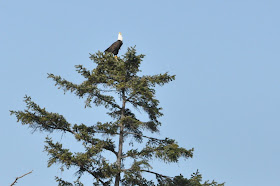It's strange weather in US this spring: the eastern two-thirds of the country are experiencing unseasonably warm temperatures and, as a result, very early spring migrations. Not so here on the west coast, where winter is hanging on with lots of wind, rain, and even a few sea level snow flurries. The weather over the last few weeks hasn't been too great for getting out a lot.
Last weekend I did go out for a walk at the Lime Kiln quarry, where the highlight was seeing my first Hutton's vireo (158) of the year. It was in with a very winter-like mixed flock of chestnut-backed chikadees, ruby- and golden-crowned kinglets, and dark-eyed juncos.
There were a couple awesome sightings right off our front porch recently, too. We've seen a river otter a couple of times, and one afternoon it was actively fishing between the two docks. While I was watching, it hopped right up on the dock at the base of our stairs to eat a fish, and didn't seem to mind me being there with the camera at all!
The fishing must be good right here, because we've continued to see all three (common, red-breasted, and hooded) merganser species too. This female common merganser caught a dock shrimp right off the houseboat on this rainy afternoon. I love how you can see the serrated teeth:
This weekend the weather has finally started to feel spring-like, so I got out for a few hours of birding both days. On Saturday, the highlight was my first San Juan swallows of the year; there were about a dozen tree swallows over Sportsman Lake. I also heard my first county marsh wren of the year there, but I saw both those species in California back in February, so they weren't year birds.
While there aren't a lot in the way of spring migrants here just yet, the winter birds are noticeably starting to decline in abundance. The flocks of ducks are much smaller, and I saw only two trumpeter swans yesterday.
Saturday I spent most of the time inland because it was pretty windy out, but with a calmer day today I headed to the south end of the island. It was a beautiful, sunny afternoon down at Cattle Point.
For the first 10 minutes or so the only bird species I saw were a couple of glaucous-winged gulls and a flock of house finches, but after a little over an hour there I had upped that total to more than 25 species. There were still a few surf scoters and horned grebes in Cattle Pass, and I was thrilled to also see my first-ever eared grebe in San Juan County. I also saw a small flock of harlequin ducks and 8 black oystercatchers.
An eagle flew over Goose Island, stirring up all the gulls, and then went and perched in this tree. Here it is calling to its mate who was circling high overhead:
Another good find was this mourning dove, an uncommon species on San Juan Island. Usually I just see and hear Eurasian collared-doves at this location.
As I was walking back towards my car, I heard the unmistakable sound of a rufous hummingbird (year bird 159) doing an aerial display. I hung out long enough to watch it do several big parabolic dives. I only saw a male, but presumably there was a female nearby watching too! Then, while I was looking up immature scoter plummages in my field guide while sitting in the car, a single violet-green swallow (160) flew over! Not bad!
I also went for a walk over by South Beach, where it wasn't very birdy, but I did see about five western meadowlarks. It's a weird transitional time right now. There aren't very many birds around numbers-wise, but you can see small numbers of both winter and spring species. Hopefully this nicer weather will continue and some of our other migrants will start showing up soon!
Finally, I had to pull over to photograph this very nice looking red fox, still sporting his/her plush winter coat:













